Related Research Articles

Basidiomycota is one of two large divisions that, together with the Ascomycota, constitute the subkingdom Dikarya within the kingdom Fungi. Members are known as basidiomycetes. More specifically, Basidiomycota includes these groups: agarics, puffballs, stinkhorns, bracket fungi, other polypores, jelly fungi, boletes, chanterelles, earth stars, smuts, bunts, rusts, mirror yeasts, and Cryptococcus, the human pathogenic yeast.

Rusts are fungal plant pathogens of the order Pucciniales causing plant fungal diseases.

Joseph Charles Arthur was a pioneer American plant pathologist and mycologist best known for his work with the parasitic rust fungi (Pucciniales). He was a charter member of the Botanical Society of America, the Mycological Society of America, and the American Phytopathological Society. He was an elected member of both the American Philosophical Society and the American Academy of Arts and Sciences. He was a recipient of the first Doctorate in Sciences awarded by Cornell University. The standard author abbreviation Arthur is used to indicate this person as the author when citing a botanical name.

The Pucciniaceae are a family of rust fungi that cause plant diseases, mainly on cereals such as wheat. The family contains over 4900 species: many of them in the type genus Puccinia.

Julius Oscar Brefeld, usually just Oscar Brefeld, was a German botanist and mycologist.

Pucciniomycetes is a diverse class of fungi in the subphylum Pucciniomycotina of phylum Basidiomycota. The class contains 5 orders, 21 families, 190 genera, and approximately 8,016 species. It has been estimated that this class contains about one third of all teleomorphic basidiomycetes. Pucciniomycetes contains many economically important plant pathogenic fungal rusts; the order Pucciniales is the largest clade in this class, representing approximately 7,000 species.

The Chaconiaceae are a family of rust fungi in the order Pucciniales. The family contained 8 genera and 75 species in 2008. By 2020, there were 8 genera and 84 species.
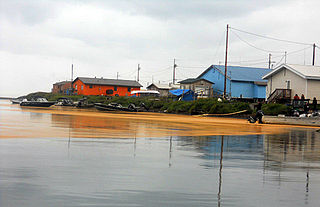
The Coleosporiaceae are a family of rust fungi in the order Pucciniales. The family contains 6 genera and 131 species. It was updated in 2020, to 7 genera and 173 species.
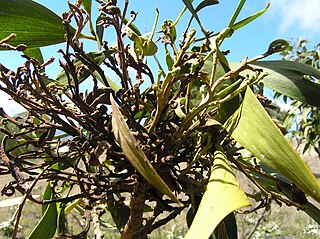
The Pileolariaceae are a family of rust fungi in the order Pucciniales. A 2008 estimate places contains 4 genera and 34 species in the family.
The Pucciniosiraceae are a family of rust fungi in the order Pucciniales. The family contains 10 genera and 57 species.
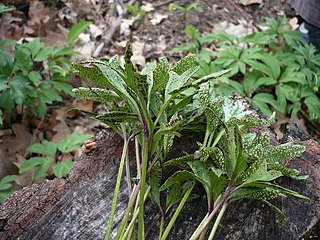
The Uropyxidaceae are a family of rust fungi in the order Pucciniales. The family contains 15 genera and 149 species.
Achrotelium is a genus of rust fungi in family Zaghouaniaceae. The genus, previously placed in the Chaconiaceae, contains five species that are found in the USA, Philippines, India, and Zimbabwe.

Botryorhiza is a genus of rust fungi in the family Zaghouaniaceae. The genus, previously placed in the Chaconiaceae, is monotypic, containing the single species Botryorhiza hippocrateae, which grows on Hippocratea plants in Brazil and the Caribbean.
George Baker Cummins was a notable American mycologist and was considered an authority on the rust fungi. At his death he was the last surviving charter member of the Mycological Society of America.

Uromycladium tepperianum is a rust fungus that infects over 100 species of Acacia and related genera including Paraserianthes in Australia, south-east Asia, the south Pacific and New Zealand. The acacia gall rust fungus species Uromycladium tepperianum has been introduced to South Africa as a biological control on the invasive Australian shrub Acacia saligna.

The Collematineae are an suborder of rust fungi in the order of Peltigerales in the class Lecanoromycetes.
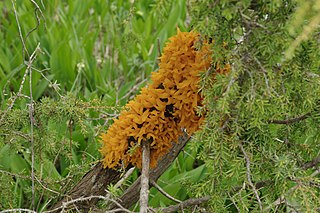
The Gymnosporangiaceae are a family of rust fungus genera, in the order Pucciniales, based on the type genus Gymnosporangium. The classification of fungal taxa based on only morphological characteristics has long been recognised as problematical, so this order was reviewed over a long term study using three DNA loci and published in 2021.

The Zaghouaniaceae are a family of rust fungus genera, some of which have long been considered incertae sedis in the order Pucciniales, based on the type genus Zaghouania. The classification of fungal taxa based on only morphological characteristics has long been recognised as problematical, so this order was reviewed over a long-term study using three DNA loci and published in 2021.
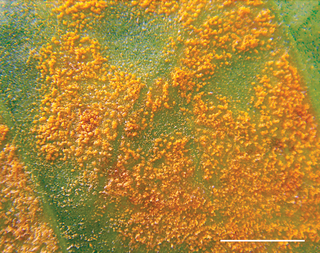
Hemileia is a genus of rust fungi, now placed in the family Zaghouaniaceae, but long considered incertae sedis in the order Pucciniales. This genus has a pan-tropical distribution and includes important crop plant pathogens, such as the causative organism of coffee leaf rust.
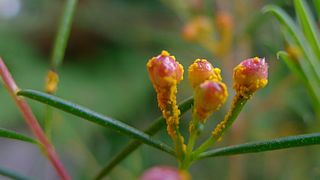
The Sphaerophragmiaceae are a family of rust fungus genera in the order Pucciniales, based on the type genus Sphaerophragmium and placed in the suborder Uredinineae.
References
- 1 2 Aime MC, McTaggart AR (2021) A higher-rank classification for rust fungi, with notes on genera. Fungal Syst. Evol. 7: 21–47. (Published online 2020 Nov 13. doi: 10.3114/fuse.2021.07.02; available at NCBI)
- ↑ Kirk PM, Cannon PF, Minter DW, Stalpers JA (2008). Dictionary of the Fungi (10th ed.). Wallingford, UK: CABI. p. 429. ISBN 978-0-85199-826-8.